Today it seems like everyone has an idea for a mobile application.
This isn’t surprising.
The mobile industry is trending upward from both the consumer and business perspectives.
But before you dive in head first and start development, you’ve got to do some research.
Find out what types of apps make the most money if you think your idea might be the next big hit like Instagram or Snapchat.
If you’re trying to improve your existing company, you’ll need to crunch some numbers to figure out if it’s worth it to build a mobile app for your business.
But most importantly, how much does it cost to make an app?
I get this question all of the time.
If you ask 10 people this question, you’ll get 10 different answers.
The reality is – it depends.
That may not be the answer you were looking for, but let me give you an analogy you that can relate to.
How much does it cost to buy a car?
There isn’t a one size fits all answer.
It depends on lots of different factors.
Well, same goes for mobile app development.
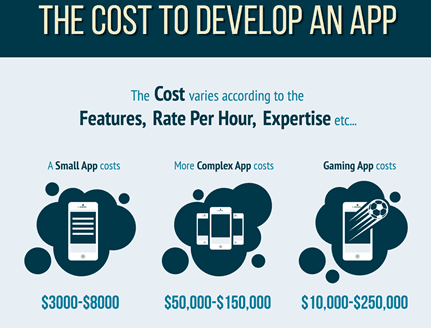
These numbers aren’t set in stone, but they give you an idea of vast price range.
There is no “out the door” price either.
Your app will continue to cost you money even after development is completed.
Think back to the car analogy. You’ve got to put gas in it, oil, get regular maintenance, change the tires, brakes, and much more.
As an industry expert who has lots of experience building mobile apps, I can help clarify some of the pricing for you.
Factors that influence app development
It’s important to know what you want before you get started.
I wouldn’t recommend jumping into the development stages without a clear plan, strategy, and goal for your app.
Here are some things to consider to get you started in the right direction.
- What’s the primary function of your app?
- What is your budget?
- How do you plan on building it?
- What kind of time frame do you envision from production start to launch?
You’ll also want to consider your launch strategy, so you can get downloads and even come up with a way to get ranked in the App Store.
So start writing a complete business plan for your app development.
This plan should recognize that there are different stages for developing your app.
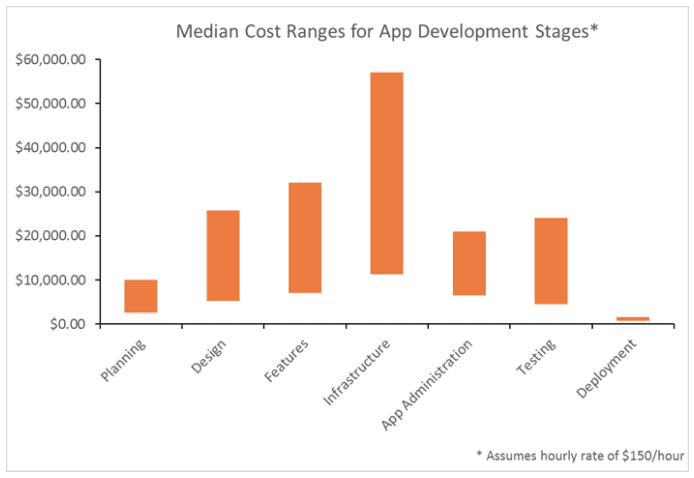
You’ve got to plan and budget accordingly for each stage.
In order to make sure you’ve got enough money to pay for each stage, you’ll need to consider where your funds are coming from.
The last thing you want is to run out of money halfway through the project due to poor budgeting.
Then you’ve got a partially developed app that’s worth nothing and no way to get your money back.
If you own an existing business it may be easier for you to secure funding.
You can use money from your company’s checking account to pay for this.
You’ll also have more luck going to a bank for a loan and borrowing against the business to secure a line of credit.
For those of you that are planning to develop a new app as a startup company, you’ll likely need to raise money from investors unless you’re independently wealthy.
Jason Calacanis, a successful entrepreneur, and angel investor, recommends raising $750,000 to get started.
Don’t get thrown off by that number.
That’s not necessarily how much it will cost you to develop an app (although it might be).
Jason factors in paying for a small team to work on the startup company and other fees associated with operating a business, in addition to paying for development.
We’ll discuss the cost of paying employees shortly.
I’ve come up with a guide that breaks down the factors impacting the cost of mobile app development into six major categories.
- Overhead
- Complexity
- Server hosting
- Operation system
- Who builds it
- Type of App
I’ll go through each one of these factors and explain everything you need to know to get a better understanding of how much development will cost for your own unique situation.
Overhead
By definition, overhead consists of the indirect or fixed costs over running a business.
As I said earlier, your app is a business, so you’ve got to treat it as such.
I want to double back and finish the thought that we previously discussed regarding the payment of employees.
If you have an existing company and infrastructure in place, you may not need to hire anyone else to help you with your app.
You can work with your marketing team or IT department.
However, if you’re starting a business from scratch and launching an app with it, you’ll probably need some help.
The majority of startup companies have 5 employees or less.
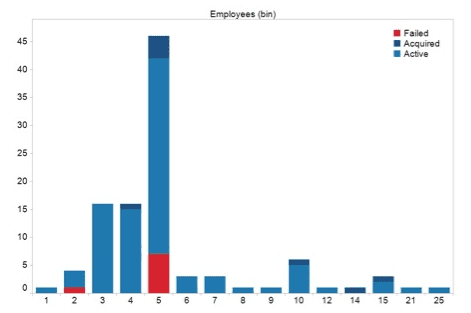
So take that into consideration if you’re planning to hire people to help you with this process.
You’re going to have to pay these people.
Nobody is going to come help you for free unless they have some sort of equity stake in the company.
You’re also going to have to pay people to perform general maintenance on the app even after it launches.
The cost will depend on how much time and effort you’re expecting this person or these people to put into it.
Maintenance may very well be at least one full time position.
In order to build a successful app, you’re going to constantly make changes and improvements along the way.
Nobody’s app is perfect.
Even the highest performing mobile apps in the world have bugs and glitches that need to be worked out.
Your business won’t be immune to this.
Marketing and promotional costs would also fall under the overhead category.
What’s your company’s marketing budget for app promotion?
This is an absolute necessity.
Your app won’t get any downloads or make any money if nobody knows about it.
For those of you that already have an existing business, the promotion will be a little bit easier.
You’ve already got marketing channels set in place such as email, your website, and social media platforms.
Using those methods will help keep marketing costs down, but it won’t be completely free.
Promoting a brand new app from scratch without an existing business in place will be more expensive.
Complexity
How complex is your app?
Your answer will impact the cost.
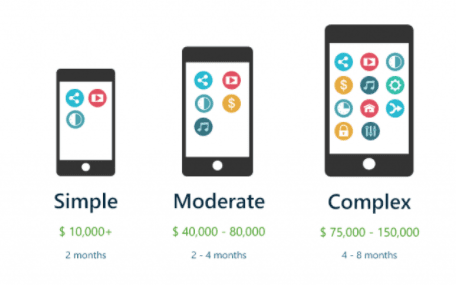
This graphic displays how complexity can also impact the length of development in addition to the cost.
I think the graph is a little bit modest as well.
Some apps can even run up to a $1 million.
So how do you know if your app is simple, moderate, or complex?
Here are some basic differences.
Simple:
- Basic features like email subscription, social media login, calendars
- Doesn’t have any back-end standard UI components
- Could cost up to $40,000 to develop
Moderate:
- Completely customized UI features
- Accepts payment
- Has API integration
- Adaptable for headsets and tablets
- Back-end server
- Roughly $80,000 to build
Complex:
- Third party integration support
- Multiple languages
- Customized animations
- Complex back-end
- Real-time results
- Designed by professional developers
- Costs $150,000+
So take a look at the structure, features, and functionality of your app.
See what category it falls into.
If you’re just looking for something super basic with minimal features, you can get develop it at a low rate.
But for those of you that have a more intricate design, the complexity is going to be more expensive.
Server and data hosting location
We briefly touched on this topic in the last section, but it’s worth going into a greater discussion about it.
Your server and hosting plan will factor into the cost of development.
As we just saw, any app that has a back-end server will be more expensive to host.

Even if you want to develop an app without a server, it will still cost you at least $25,000 or so if you want it done properly by a professional.
You can find self hosting services or an AWS or cloud hosting service for your app.
Shop around to find the best price that different services have to offer.
Just make sure you understand what you’re looking for.
On one side of the spectrum, you don’t want to overpay for something that you don’t need.
But you also don’t want to just go with the cheapest option.
You get what you pay for.
Don’t let your app suffer by selecting a server hosting plan that’s inadequate.
Think about your company’s website as an example.
Selecting the right hosting service ensures that your site runs smoothly without interruption.
Same goes for your app.
If your app is having problems, it’s not a viable way to keep users happy and make money.
Operating system to develop on
The operating system also factors into the price.
There are pros and cons to both hybrid and native app development.

Native apps focus more on the user experience.
They work fast and are optimized for performance.
You can also process lots of features at the same time if you have a native app.
Depending on how many different platforms you want to support, native apps will be more expensive.
Native apps are also easier to find in the App Store and Google Play Store.
Some examples of different types of native apps include:
- Apps for entertainment
- Educational apps
- Business apps
Hybrid apps are better for multiple platforms and devices.
They use the same code for each platform, so generally, it’s less expensive to launch a hybrid app.
The user experience isn’t as optimal for hybrid development.
If you have a small or medium sized lifestyle application, communication app, or simple game, you may want to consider developing a hybrid app.
Who builds it
If you’ve never built an app before, I don’t recommend learning how to do it from scratch right now.
Sure, you could take the time and learn to code and do it all yourself if you want the cheapest option.
But that’s a long road with lots of obstacles along the way.
Your finished product won’t have the same quality as it would if you outsourced it to a professional.
You could go a couple of different routes with finding a developer.
If your app isn’t too complicated, you may be able to find a freelancer who develops apps on their own.
This may be the least expensive option, but you’re relying on just one person to complete the process.
There’s nothing you can do if this person doesn’t complete project on time.
Plus, if they take on too many developments at once, they may not put full effort into building your app.
So instead, you find an app development agency.
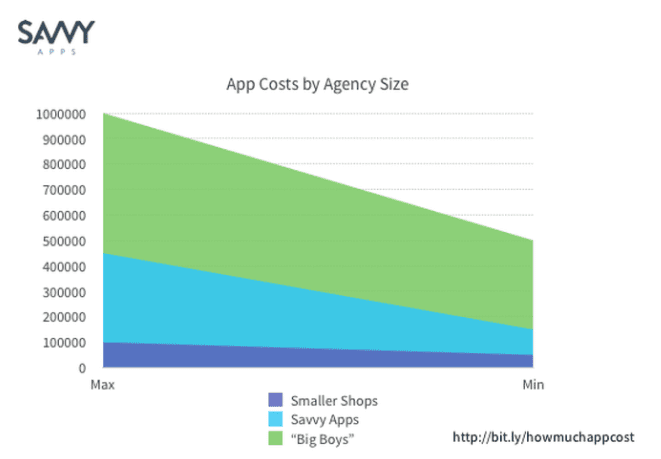
The cost of the agency will depend on some of the factors we’ve looked at so far, but also depend on the size of the agency.
A smaller shop may have a team of just two or three people.
This could cost somewhere between $50,000 and $100,000 to develop.
If you can find a medium sized agency, the cost will fall somewhere in the range of $150,000 to $450,000.
Hiring a large app development corporation to develop your app would start around $500,000 and go all the way up toward $1,000,000.
You can also find a service like BuildFire’s platform to build your app without learning how to code.
I know I’m biased, but BuildFire’s system is super easy to learn how to use.
Plus the Pro Services team is available if you need any help throughout the process.
If you don’t have time to build your app on this platform, BuildFire can do it for you.
Just consult with one of the team members and explain what exactly you’re looking for.
BuildFire will take care of the rest.
Once your app launches, it’s easy to make changes and adjustments for regular app maintenance as well.
Compared to some of the other options we’ve looked at, this will likely be your most cost efficient solution.
It can also help you bring your app to the market faster than going through an agency.
Type of app: The primary function and type of app will factor into your development costs as well.
Let’s go through some examples.
A standalone app such as clock or calculator with basic functions would cost up to $50,000.
Apps like this can function without being connected to a network.
Since the complexity is minimal, the price will be low as well.
An app that uses data consumption such as a calendar, stock market watch, or a weather application would likely fall in the $50,000 to $100,000 range.
These are similar to standalone apps in terms of the complexity, but they require additional features to get results in real time.
Apps that require user authentication like ESPN Fantasy Sports or Google Drive can cost up to $300,000.
These are more complex and customized for each user.
Your app has to function for everyone’s specific account.
If you want to take that user experience one step further and develop a social media app like Facebook or Snapchat, it could cost up to $500,000.
Dating apps like Tinder or Bumble would fall into this category as well.
Ecommerce apps have a wide price range depending on the company. These can run anywhere from $200,000 to $1,000,000.
An on-demand app where users get results in real time like Uber or Postmates can be one of the most expensive apps to develop.
On-demand apps can cost up to $1,500,000 to build.
Here’s a great visual representation of these various price ranges based on the app type.

So take a look at the app you’re planning to develop.
Based on what category it falls under can help give you a rough estimate of the development costs.
Hidden final costs
OK, so that’s everything – right?
Not so fast.
While you may have spent more than you originally anticipated building your app, you’re not quite out of the woods yet.
Don’t forget about some of the costs that people often overlook during this process.
You’re going to pay legal fees.
Like any good business, you’re going to need to hire a lawyer.
The lawyer will help protect your copyrights, trademarks, intellectual property, and everything else that you need while making sure you’re not infringing on anyone else’s business.
Legal fees will also cover filing any paperwork required to launch a new business if you don’t already have one in place.
Don’t forget about subscription fees for external functions either.
I’m referring to third party services like SMS, email, and push notifications and API integrations.
So don’t come up with a budget that you can’t manage.
Make sure you have some breathing room in your budget for these hidden costs and anything else that may surprise you or come up along the way.
It’s always better to plan on spending more and end up spending less as opposed to the other way around.
Conclusion
So how much does it cost to make an app?
As you’ve just learned, there’s no black and white or clear cut answer to that question.
Everyone’s situation is unique, and the prices will reflect that.
There are basic factors that influence the cost of development.
Start with your overhead.
This includes maintenance, employee salaries, and other fixed costs.
Next, look at the complexity of your app.
The structure, features, and functionality will impact the price.
Explore different options when it comes to your server and data hosting as well.
Finding the best operating system to develop on for your app is something else you’ll need to figure out.
Are you going to build a hybrid or native app?
Each has pros and cons, but the price isn’t the same.
Finding an agency or contractor to develop your app will impact the price tool.
Or you could build it through a platform like BuildFire to save time and money throughout this process.
Don’t forget about those final hidden costs like legal fees and subscriptions.
What type of app are you planning to develop and how do you think that will influence the cost?